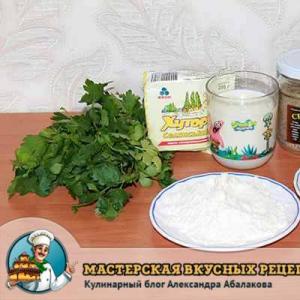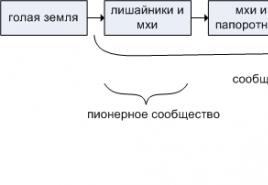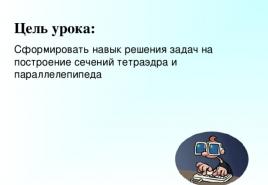Section of polyhedra. Presentation on the topic "construction of sections of polyhedra" One point of intersection
Chudaeva Elena Vladimirovna, mathematics teacher,
Municipal educational institution "Insarskaya secondary school No. 1",
Insar, Republic of Mordovia
Construction of sections of polyhedra
Educational and methodological support: Atanasyan L.S. and others. Geometry grades 10-11.
Equipment and materials for the lesson: computer, projector, screen, presentation to accompany the lesson, student handouts.
The purpose of the lesson: deepening, generalization, systematization, consolidation of acquired knowledge and their development in the future (study the trace method)
Lesson objectives:
1. To create motivation among schoolchildren to study this topic.
2. Develop in students the ability to use basic knowledge to gain new knowledge.
3. Develop students’ thinking (the ability to identify essential features and make generalizations).
4. Develop in students the skills of a creative approach to solving problems and the skills of research work on a problem.
Knowledge, abilities, skills and qualities that students will consolidate during the lesson:
the ability to use basic knowledge to obtain new knowledge;
the ability to identify essential features and make generalizations;
skills of a creative approach to solving problems involving the construction of sections
Lesson plan:
1. Formation of motivation among schoolchildren to study this topic.
2. Checking homework. Historical information.
3. Repetition of basic knowledge (axiomatics, methods of defining a plane).
4. Application of knowledge in a standard situation.
5. Studying and consolidating new material: the trace method.
6. Independent work.
7. Summing up the lesson.
8. Homework.
During the classes: I stage – Introductory conversation.
Checking homework. (6-7 min)
Forms and methods of work
Activities
students
1.Motivation
Introductory conversation (1 min)
Teachers listen
2. Checking homework
Comments on student mini-speeches
Listen to the speeches of their comrades, ask questions
II stage– Updating knowledge (10 min)
(repetition of theoretical material)
Forms and methods of work
Activities
students
1. Repetition of the axioms of stereometry
2. Repetition: relative position in space of lines and planes
3. Generalization of the theory
Conclusion about methods for defining a plane
Recording the output in a notebook
4. Repetition of the concept of a polyhedron and the section of a polyhedron by a plane
Student Survey
Oral answers to teacher questions
III stage– Application of knowledge in a standard situation (6-7 min)
(work according to ready-made drawings)
Forms and methods of work
Activities
students
Solving typical problems using ready-made drawings (each student is given a worksheet with the conditions of the problem and a drawing for constructing a section).
Joint solution of the first problem (detailed commenting on the steps of the solution and recording the design in a worksheet).
Studying the conditions of the problem, working on ready-made drawings, followed by analyzing the solution from the slides.
IV stage–WITHproperties of parallel planes (6 min)
Forms and methods of teacher work
Types of student activities
1. Repetition of the topic “Parallelism of planes.”
2. Problem solving
Working on ready-made slides (frontal survey of students)
Checking the correctness of the task
Oral answers to teacher questions
Constructing sections in a worksheet.
The answers are on the board.
Stage V - Access to new knowledge: “Method of traces” (6 min)
Forms and methods of work
Activities
students
1. Learning new material
2. Consolidation of new material
Explanation of new material. Showing an educational fragment of the educational film “How to construct a cross-section of a cube?”
Work from ready-made drawings at the board (with subsequent commenting on the stages of constructing a section on a slide)
Listen to the teacher's explanation. Watching an educational film. Analysis of video fragments, recording a sample solution.
Two students solve at the board, the rest on the worksheet
VI stage - Independent work (4-5 min)
Forms and methods of work
Activities
students
Independent educational work
Explanation of the work to be done.
Checking the completion of the task.
Carrying out independent work (using ready-made drawings).
Self-test using ready-made slides.
VII stage– summing up the lesson (4 min)
Forms and methods of work
Activities
students
1. Summing up
2. Creative homework
Post-lesson discussion using slides
Projected onto screen
Oral answers to teacher questions
Entry in diaries
DURING THE CLASSES
Introductory conversation. Historical information.
Teacher: Hello guys! The topic of our lesson is “Construction of sections of polyhedra based on axiomatics.” During the lesson we will summarize and systematize the theoretical material covered, and apply it to practical problems on constructing sections, reaching a new, more complex level of task difficulty.
the main objective our lesson in deepening, systematizing, consolidating the acquired knowledge and their development in the future.
As homework, you were asked to write essays or short speeches about the history of the development of geometry, about the lives of great mathematicians, about their famous discoveries and theorems. The reports and abstracts turned out to be very interesting, but during the lesson we will only hear three mini-speeches answering the question: what does stereometry study, how did it arise and develop, and where is it used?
1 student. The concept of stereometry, which is studied. (2 minutes)
2 student. Euclid - the founder of geometry, Greek architecture. (2 minutes)
3 student. Mathematical theory of painting. The “Golden Ratio” is the formula for the perfect human body according to Leonardo da Vinci. (2 – 3 min)
IN stereometry beautiful mathematical objects are studied. Their forms find their application in art, architecture, and construction. “It is no coincidence that they say that the Cheops pyramid is a silent treatise on geometry, and Greek architecture is the external expression of Euclid’s geometry,” wrote the architect Corbusier.
Centuries have passed, but the role of geometry has not changed. It remains the "architect's grammar." Geometric shapes find their application in art, architecture, and construction.
Mathematical theory of painting – This is the theory of perspective, which represents, in the words of Leonardo da Vinci, “a most subtle study and invention, based on the study of mathematics, which, by the power of lines, made what was near appear distant, and what was small, large.” The construction of engineering structures that unfolded during the Renaissance revived and expanded the techniques of projection images used in the ancient world. Architects and sculptors faced the need to create a doctrine of pictorial perspective on a geometric basis. Numerous examples of constructing perspective images are available in the works of the brilliant Italian artist and outstanding scientist Leonardo da Vinci. For the first time, he talks about reducing the scale of different segments receding into the depths of the picture, lays the foundation for panoramic perspective, indicates the rules for the distribution of shadows, and expresses confidence in the existence of a certain mathematical formula for the beauty of the ratio of the sizes of the human body - the “golden ratio” formula.
Thus, we smoothly approached the topic of our lesson, and the bridge to its next stage will be the words of Leonardo da Vinci:
“Those who fall in love with practice without theory are like a sailor who boards a ship without a rudder or compass and therefore never knows where he is sailing.”
This statement defines the next stage of our lesson: repetition of theoretical material.
II. Updating knowledge (repetition of theoretical material)
2.1. Axioms of stereometry (tables are left for students to work on).
a) explain the content of the axioms and illustrate them with a model;
b) students reading the text of axioms;
c) execution of the drawing;
2.2. Corollaries from the axioms of stereometry.
2.3. The relative position in space of straight lines and planes.
a) two lines (lines are parallel, intersect, cross)
b) straight line and plane (the straight line lies in the plane, intersects the plane, is parallel to the plane)
c) two planes (the planes intersect or are parallel).
During the conversation, the essential points of the theory are highlighted:
a) Sign of parallelism between a line and a plane: If a line not lying in a given plane is parallel to some line lying in this plane, then it is parallel to the given plane.
b) Sign of parallel planes: If two intersecting lines of one plane are respectively parallel to two intersecting lines of another plane, then these planes are parallel.
Teacher: Summarizing all that has been said, we come to the conclusion about methods for defining a plane.
2.5. The concept of polyhedra. Section.
Polyhedron is a body limited by a finite number of planes. The surface of a polyhedron consists of a finite number of polygons.
M
the polyhedron obtained by intersecting a polyhedron and a plane is called cross section
polyhedron by the indicated plane
.
III. Application of knowledge in a standard situation.
Using the acquired knowledge, we will apply it to the construction of sections of polyhedra based on axiomatics.
Examples and their solutions are given by students (under the guidance of the teacher).
IV. Constructing sections using the properties of parallel planes.
Teacher: To solve the next group of problems, we need to repeat the properties of parallel planes.
V. A way to gain new knowledge: “The trace method.”
Watching an educational film.
Electronic edition
Application of acquired knowledge (students solving two problems at the board and then viewing the correct solution and recording the design).
VI- Independent work
followed by mutual verification (using a slide with a ready-made solution).
VII. Summing up the lesson
What new did you learn in the lesson?
How is the cross section of a tetrahedron constructed?
What polygons can be a section of a tetrahedron?
What polygons can be obtained in the section of a parallelepiped?
What can you say about the trace method?
Creative homework. Compose two problems for constructing sections of polyhedra using the acquired knowledge.
Used sources
The prototype of this lesson was the author's lesson Legkoshur Irina Mikhailovna , addition changes and presentation for the lesson were made with her permission in 2008. Link:
Atanasyan L.S. and others. Geometry grades 10-11. Tutorial.
Electronic edition "1C: School. Mathematics, 5-11 grades. Workshop"
Electronic edition " Geometry workbook. Guide for applicants. Full course for grades 7-11"
Tasks for constructing sections
Definitions. 1. The secant plane of a tetrahedron (parallepiped) is any plane on both sides of which there are points of a given tetrahedron (parallepiped). 2. A polygon whose sides are segments intersecting the faces of a tetrahedron (parallepiped) is called a section of a tetrahedron (parallepiped).
Sections of a tetrahedron and parallelepiped
A B C S Task 1. Construct a section with a plane passing through the given points D, E, K. D E K M F Construction: 2. EK 3. EK ∩ AC = F 4 . FD 5. FD ∩ B C = M 6. KM 1. DE D E K M – required section
Explanations for the construction: 1. Connect points K and F, belonging to the same plane A 1 B 1 C 1 D 1. A D B 1 B C A 1 C 1 D 1 Problem 2. Construct a section with a plane passing through the given points E, F, K. K L M Construction: 1. KF 2. FE 3. FE ∩ A B = L EFKNM – the required section F E N 4 . LN ║ FK 6. EM 5. LN ∩ AD = M 7 . KN Explanations for construction: 2. Connect points F and E, belonging to the same plane AA 1 B 1 B. Explanations for construction: 3. Lines FE and AB, lying in the same plane AA 1 B 1 B, intersect at point L. Explanations for the construction: 4. We draw straight line LN parallel to FK (if the cutting plane intersects opposite faces, then it intersects them along parallel segments). Explanations for the construction: 5. Line LN intersects edge AD at point M. Explanations for the construction: 6. We connect points E and M belonging to the same plane AA 1 D 1 D. Explanations for the construction: 7. We connect points K and N belonging to the same plane BCC 1 B 1.
A D B 1 B C A 1 C 1 D 1 Problem 3. Construct a section with a plane passing through points K, L, M. K L M Construction: 1. ML 2. ML ∩ D 1 A 1 = E 3. EK M LFKPG – required section F E N P G T 4 . EK ∩ A 1 B 1 = F 6 . LM ∩ D 1 D = N 5 . LF 7. E K ∩ D 1 C 1 = T 8 . NT 9. NT ∩ DC = G NT ∩ CC 1 = P 10 . MG 11. PK
A D B 1 B C A 1 C 1 D 1 Problem 4. Construct a section with a plane passing through the points T, H, M, M∈AB. N T M Construction: 1. NM 1. MT 1. N T Choose the correct option:
A D B 1 B C A 1 C 1 D 1 Problem 4. Construct a section with a plane passing through the points T, H, M, M∈AB. N T M Construction: 1. NM Comments: These points belong to different faces! Back
A D B 1 B C A 1 C 1 D 1 Problem 4. Construct a section with a plane passing through the points T, H, M, M∈AB. N T M Construction: 1. M T Comments: These points belong to different faces! Back
A D B 1 B C A 1 C 1 D 1 Problem 4. Construct a section with a plane passing through the points H, M, T. N T M Construction: 1. NT 2. NT ∩ D C = E 2. NT ∩ B C = E Choose the correct option:
A D B 1 B C A 1 C 1 D 1 Task 4. Construct a section with a plane passing through the points H, M, T. N T M Construction: 1. NT 2. NT ∩ BC = E Back Comments: These straight lines are intersecting ! They can't intersect!
A D B 1 B C A 1 C 1 D 1 Problem 4. Construct a section with a plane passing through the points H, M, T. N T M Construction: 1. NT 2. NT ∩ D C = E E 3. ME ∩ AA 1 = F 3 . ME ∩ B C = F 3 . ME ∩ CC 1 = F Choose the correct option:
A D B 1 B C A 1 C 1 D 1 Task 4. Construct a section with a plane passing through points H, M, T. N T M Construction: 1. NT 3. ME ∩ AA 1 = F 2. NT ∩ D C = E E Back Comments: These straight lines are crossed! They can't intersect!
A D B 1 B C A 1 C 1 D 1 Task 4. Construct a section with a plane passing through points H, M, T. N T M Construction: 1. NT 3. ME ∩ CC 1 = F 2. NT ∩ D C = E E Back Comments: These straight lines are crossed! They can't intersect!
A D B 1 B C A 1 C 1 D 1 Problem 4. Construct a section with a plane passing through the points H, M, T. N T M Construction: 1. NT 2. NT ∩ D C = E E 3 . ME ∩ BC = F F 4. N F 4. T F 4. MT Choose the correct option:
A D B 1 B C A 1 C 1 D 1 Problem 4. Construct a section with a plane passing through the points H, M, T. N T M Construction: 1. NT 2. NT ∩ D C = E E 3 . ME ∩ ВС = F F 4. Н F Comments: These points belong to different faces! Back
A D B 1 B C A 1 C 1 D 1 Problem 4. Construct a section with a plane passing through the points H, M, T. N T M Construction: 1. NT 2. NT ∩ D C = E E 3 . ME ∩ ВС = F F 4. MT Comments: These points belong to different faces! Back
A D B 1 B C A 1 C 1 D 1 Problem 4. Construct a section with a plane passing through the points H, M, T. N T M Construction: 1. NT 2. NT ∩ D C = E E 3 . ME ∩ BC = F F 4. T F 5. T F ∩ A 1 A = K 5. T F ∩ B 1 B = K Choose the correct option:
A D B 1 B C A 1 C 1 D 1 Problem 4. Construct a section with a plane passing through the points H, M, T. N T M Construction: 1. NT 2. NT ∩ D C = E E 3 . ME ∩ BC = F F 4. T F 5. T F ∩ A 1 A = K Comments: These straight lines are crossing! They can't intersect! Back
A D B 1 B C A 1 C 1 D 1 Problem 4. Construct a section with a plane passing through the points H, M, T. N T M Construction: 1. NT 2. NT ∩ D C = E E 3 . ME ∩ BC = F F 4. T F 5. T F ∩ B 1 B = K K 6. M K ∩ AA 1 = L 6. N K ∩ A D = L 6. T K ∩ A D = L Choose the correct option:
A D B 1 B C A 1 C 1 D 1 Problem 4. Construct a section with a plane passing through the points H, M, T. N T M Construction: 1. NT 2. NT ∩ D C = E E 3 . ME ∩ BC = F F 4. T F 5. T F ∩ B 1 B = K K 6. N K ∩ A D = L Comments: These straight lines are crossed! They can't intersect! Back
A D B 1 B C A 1 C 1 D 1 Problem 4. Construct a section with a plane passing through the points H, M, T. N T M Construction: 1. NT 2. NT ∩ D C = E E 3 . ME ∩ BC = F F 4. T F 5. T F ∩ B 1 B = K K 6. T K ∩ A D = L Comments: These straight lines are crossed! They can't intersect! Back
A D B 1 B C A 1 C 1 D 1 Problem 4. Construct a section with a plane passing through the points H, M, T. N T M Construction: 1. NT 2. NT ∩ D C = E E 3 . ME ∩ BC = F F 4. T F 5. T F ∩ B 1 B = K K 6. M K ∩ AA 1 = L L 7. LT 7. LF 7. LH Choose the correct option:
A D B 1 B C A 1 C 1 D 1 Problem 4. Construct a section with a plane passing through the points H, M, T. N T M Construction: 1. NT 2. NT ∩ D C = E E 3 . ME ∩ BC = F F 4. T F 5. T F ∩ B 1 B = K K 6. M K ∩ AA 1 = L L 7. L T Comments: These points belong to different faces! Back
A D B 1 B C A 1 C 1 D 1 Problem 4. Construct a section with a plane passing through the points H, M, T. N T M Construction: 1. NT 2. NT ∩ D C = E E 3 . ME ∩ BC = F F 4. T F 5. T F ∩ B 1 B = K K 6. M K ∩ AA 1 = L L 7. LF Comments: These points belong to different faces! Back
A D B 1 B C A 1 C 1 D 1 Problem 4. Construct a section with a plane passing through the points H, M, T. N T M Construction: 1. NT 2. NT ∩ D C = E E 3 . ME ∩ BC = F F 4. T F 5. T F ∩ B 1 B = K K 6. M K ∩ AA 1 = L L 7. L N NT F M L – the required section
A B C S Problem 5. Construct a section with a plane passing through the given points K, M, P, P∈ABC K M P Construction:
A B C S Problem 5. Construct a section by a plane passing through the given points K, M, P, P∈ABC K M R E N F Construction: 1. KM 2. KM ∩ CA = E 3. E P 4 . EP ∩ AB = F EP ∩ B C = N 5 . M F 6. N K KM FN – required section
Thank you for your attention!
“Five Platonic Solids” - Tetrahedron. Cube And the sphere is emptiness. Octahedron. Many polyhedra have “doubles”. The cube, being a completely closed figure, symbolizes limitation. Firstly, all faces of such a body are equal in size. Therefore, the cross generated by the unfolding of the cube also means limitation, suffering. Dodecahedron and icosahedron.
“Problems on polyhedra” - Right triangle. Triangle. Polyhedron. Octahedron. Base of a straight prism. Non-convex polyhedron. Isosceles triangle. The sum of the areas of all faces. Diagonal of a rectangular parallelepiped. Sides of the base of a right parallelepiped. Prism. Sides of the base. Side rib. Section.
““Polyhedrons” stereometry” - Epigraph of the lesson. Great Pyramid of Giza. Section of polyhedra. The finest hour of polyhedra. Correct the logical chain. Historical reference. "Playing with the Spectators" Polyhedron. Do the geometric shapes and their names correspond? Lesson objectives. Archimedean solids. Platonic solids. Please indicate the correct section.
“Geometric body polyhedron” - An earthquake destroyed the Mausoleum. Distance between planes. Elements of the pyramid. Prisms. Great Pyramid. Word. Scientists and philosophers of Ancient Greece. Corporeal figure. Application. Side edges. Ashes of the royal couple. Properties of a prism. The base of the Cheops pyramid. Octahedron. A square of any diagonal.
“The concept of a polyhedron” - Quadrangular prism. Definition. A straight prism is called regular. Edges are the sides of faces. What is a rectangular parallelepiped? Prism. Theorem. The sum of the areas of all its faces. The concept of a polyhedron. What is a parallelepiped? Polyhedra. Edges. The height of the prism is perpendicular. What is a tetrahedron?
“Stellar forms of polyhedra” - Stellar cuboctahedra. Great stellated dodecahedron. Stellated truncated icosahedron. Answer. The polyhedron shown in the figure. Stellated icosahedrons. Vertices of the great stellated dodecahedron. Stellated dodecahedron. Polyhedron. A polyhedron obtained by truncating a stellated truncated icosahedron. Great icosahedron.
There are 29 presentations in total
Construction of sections of polyhedra
Slide 2
Definition of section.
A secant plane of a polyhedron is any plane on both sides of which there are points of the given polyhedron. The cutting plane intersects the faces of the polyhedron along segments. The polygon whose sides are these segments is called a section of the polyhedron.
Slide 3
Cutting plane A B C D M N K α
Slide 4
Cutting plane section A B C D M N K α
Slide 5
In which drawings is the section constructed incorrectly?
B A A A A A D D D D D B B B B C C C C C N M M M M M N Q P P Q S
Slide 6
Construct a section of a tetrahedron by a plane defined by three points.
P N Construction: A B C D P M N 2. Segment PN A B C D M L 1. Segment MP Construction: 3. Segment MN MPN – the required section 1. Segment MN 2. Ray NP; ray NP intersects AC at point L 3. Segment ML MNL is the desired section
Slide 7
Construction: A C B D N P Q R E 1. Segment NQ 2. Segment NP Line NP intersects AC at point E 3. Line EQ EQ intersects BC at point R NQRP - the required section
Slide 8
Formation: A B C D M N P X K S L 1. MN; segment MK 2. MN intersects AB at point X 3. XP; segment SL MKLS – required section
Slide 9
Axiomatic method Method of traces The essence of the method is to construct an auxiliary line, which is an image of the line of intersection of the cutting plane with the plane of any face of the figure. It is most convenient to construct an image of the line of intersection of the cutting plane with the plane of the lower base. This line is called the trace of the cutting plane. Using a trace, it is easy to construct images of points of the cutting plane located on the lateral edges or faces of the figure.
Slide 10
Construct a section of the pyramid with a plane passing through three points M, N, P.
XY – trace of the cutting plane on the base plane D C B А Z Y X M N P S F
Slide 11
XY – trace of the cutting plane on the base plane D C B Z Y X M N P S А F
Construction of sections polyhedra
Stereometry 10th grade
Completed by a math teacher
MBOU "Molodkovskaya Secondary School"
Stepchenko M.A.

The purpose of the lesson:
Develop skills in solving problems involving constructing sections of a tetrahedron and parallelepiped

“Tell me and I will forget. Show me and I will remember..."
Ancient Chinese
proverb

This is interesting!
Many artists, distorting the laws of perspective, paint unusual pictures. By the way, these drawings are very popular among mathematicians. On the Internet you can find many sites where these impossible objects are published.
Popular artists Maurice Escher, Oscar Reutersvard, Jos de Mey and others surprised mathematicians with their paintings.

“This can only be drawn by someone who makes a design without seeing the perspective...”
Jos de Mey

The laws of geometry are often violated in computer games.
Climbing this ladder, we remain on the same floor.
A 2 . If two points are on a straight line
lie in the plane, then all points
straight lines lie in this plane.
Geometry: Textbook. For 10-11 grades. general education institutions / L.S. Atanasyan, V.F. Butuzov, S.B. Kadomtsev and others - 9th ed., as amended. – M.: Enlightenment, 2000. – 206 p.: ill. – ISBN 5-09-008612-5.
There can't be a ladder here!
A

“Those who fall in love with practice without theory are like a sailor who boards a ship without a rudder or compass and therefore never knows where he is sailing.”
Leonardo da Vinci
http://blogs.nnm.ru/page6/

AXIOMS
planimetry
stereometry
Characterize the relative position of points and lines
A1. Through any three points that do not lie on the same line, a plane passes through, and only one
1. Each line contains at least two points
A2. If two points of a line lie in a plane, then all points of the line lie in this plane
2. There are at least three points that do not lie on the same line
3. A straight line passes through any two points, and only one.
A3. If two planes have a common point, then they have a common line on which all the common points of these planes lie.
The basic concept of geometry is “to lie between”
4. Of the three points on a straight line, one and only one lies between the other two.

Plane (including secant) can be specified next way

One point of intersection
No intersection points
By crossing
is plane
By crossing
is a segment

Cutting plane parallelepiped (tetrahedron) is any plane on both sides of which there are points of a given parallelepiped (tetrahedron).

To construct a section of a polyhedron with a plane means to indicate the points of intersection of the cutting plane with the edges of the polyhedron and connect these points with segments belonging to the faces of the polyhedron.
To construct a section of a polyhedron with a plane, you need to indicate in the plane of each face 2 points belonging to the section, connect them with a straight line and find the points of intersection of this straight line with the edges of the polyhedron.
A reference guide to methods for solving problems in mathematics for high school. Tsypkin A.G., Pinsky A.I./Under. Edited by V.I. Blagodatskikh. – M.: Science. Main editorial office of physical and mathematical literature, 1983. – 416 p.

Cutting plane intersects the faces of a tetrahedron (parallelepiped) along segments
L
Polygon whose sides are these segments is called cross section tetrahedron ((parallelepiped).

Cutting plane
The cutting plane intersects the faces of the tetrahedron along segments.
A polygon whose sides are these segments - tetrahedron section .

To solve many geometric problems it is necessary to construct them sections different planes.

To construct a section, you need to construct the intersection points of the cutting plane with the edges and connect them with segments.
The following must be taken into account:
1. You can only connect two points lying
in the plane of one face.
2. A cutting plane intersects parallel faces along parallel segments.
3. If only one point is marked in the face plane, belonging to the section plane, then an additional point must be constructed. To do this, it is necessary to find the intersection points of the already constructed lines with other lines lying on the same faces.

What polygons can be obtained in a section?
A tetrahedron has 4 faces
The sections may look like:
- Quadrilaterals
- Triangles

The parallelepiped has 6 faces
- Pentagons
- Triangles
In its sections
may turn out:
- Hexagons
- Quadrilaterals

Blitz - survey
- The task of the blitz survey is to answer questions and justify the answer using axioms, theorems and properties of parallel planes.

Blitz survey.
D 1
WITH 1
Do you believe that straight lines NK and BB 1 intersect?
A 1
B 1

Blitz survey.
D 1
WITH 1
A 1
Do you believe that
direct NK and BB 1
intersect?
B 1

Blitz survey.
D 1
WITH 1
Do you believe that direct NK and MR overlap?
A 1
B 1
The drawing has
another mistake!

Do you believe that straight lines H R and NK
intersect?
Blitz survey.
WITH 1
D 1
A 1
B 1
The drawing has
another mistake!

Do the lines H R and A 1 B 1 intersect?
Blitz survey.
Do the lines H R and C 1 D 1 intersect?
D 1
WITH 1
A 1
B 1
Do they intersect?
direct NK and DC?
Do they intersect?
straight lines NK and A D?

Do you believe
that direct MO and AC
intersect?
Blitz survey.
Direct MO and AB intersect, because lie in the same plane (A D C). Direct MO and AB do not intersect, because lie in different planes (A D C) and (A D B) - these planes intersect along the straight line A D, on which all the common points of these planes lie.
Do you believe
that direct MO and AB
intersect?

The ability to solve problems is a practical art, like swimming or skiing...: you can learn this only by imitating selected models and constantly practicing...
D. Polya

Property
parallel planes.
If two parallel planes
crossed by the third,
then the lines of their intersection
parallel.
A
b
This property will help us
when constructing sections.

The simplest tasks.
D 1
WITH 1
B 1
A 1
We connect 2 points belonging to the same face of the polyhedron with segments. If you cut off the top of a pyramid, you get a truncated pyramid.

The simplest tasks.

Diagonal sections.
D 1
WITH 1
D 1
WITH 1
A 1
B 1
A 1
B 1
We connect 2 points belonging to the same face of the polyhedron with segments. Diagonal sections.

D 1
WITH 1
A 1
B 1

Axiomatic method
Trace method
- Trace method
The essence of the method is to construct an auxiliary line, which is an image of the line of intersection of the cutting plane with the plane of any face of the figure. It is most convenient to construct an image of the line of intersection of the cutting plane with the plane of the lower base. This line is called the trace of the cutting plane. Using the trace, it is easy to construct images of the points of the cutting plane located on the side edges or edges of a figure.

1. Construct sections of a parallelepiped with a plane passing through points B 1, M, N
7. Let's continue with MN and BD.
2.Continue MN,BA
5. B 1 O ∩ A 1 A=K
10. B 1 E ∩ D 1 D=P, PN

Construct a section of a polyhedron with a plane passing through the points M, R, K, if K belongs to the plane a.


Solutions to option 1.
Solutions for option 2.

Rules for self-control:
- The vertices of the section are located only on the edges.
- The sides of the section are only on the edge of the polyhedron.
- A cutting plane intersects a face or face plane only once.


If you want to learn how to swim, then boldly enter the water, and if you want to learn how to solve problems, then solve them
(D. Polya)

- Atanasyan L.S., et al. Geometry 10-11. – M.: Education, 2008.
- Litvinenko V.N., Polyhedra. Problems and solutions. – M.: Vita-Press, 1995.
- Smirnov V.A., Smirnova I.M., Unified State Examination 100 points. Geometry. Section of polyhedra. – M.: Exam, 2011.
- Educational and methodological supplement to the newspaper “First of September” “Mathematics”. Fedotova O., Kabakova T. Integrated lesson "Construction of sections of a prism", 9/2010.
- Ziv B.G. Didactic materials on geometry for grade 10. – M., Education, 1997.
- Electronic edition "1C: School. Mathematics, 5-11 grades. Workshop"
7. http://www.edu.yar.ru/russian/pedbank/sor_uch/math/legcosh/work.html







